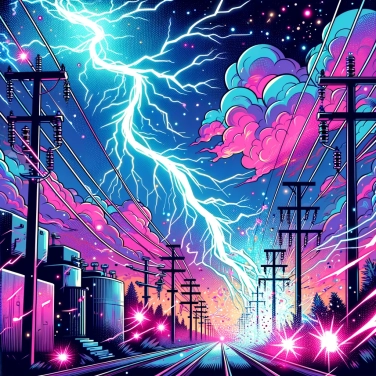Lightning strikes can cause power outages because they can strike power lines, overload transformers, or damage electrical equipment, which disrupts electricity distribution.

During a storm, the air is electrically charged and creates a huge potential difference between the clouds and the ground. When lightning strikes a conductive element like a power pole or an overhead line, it suddenly injects a large amount of electrical energy. This energy, called surge, far exceeds what the grid is designed to handle. It travels rapidly along electrical cables, reaching connected installations such as transformers or household equipment. The high voltage can damage or even burn out these devices, leading to more or less prolonged power outages. Even if lightning does not directly strike the power lines, its magnetic field can induce surges through proximity.
The surges that come with lightning cause a sudden influx of electric current in the cables and equipment connected to the network. This quickly heats up the electronic components, which can fry in no time. As a result, sometimes just one big lightning strike is enough to take out a power station or transformers, leading to a widespread outage. On a smaller scale, it is often household appliances like computers, internet boxes, televisions, or refrigerators that suffer the most. Even if the equipment doesn't fry immediately, the surge can seriously shorten its lifespan by gradually damaging its internal components. It's a bit like a sudden pressure overload in a pipe not designed to handle such pressure: it will eventually give way somewhere.
To prevent power outages caused by lightning, electrical installations often have surge protectors. These devices work by diverting the excess energy from lightning to the ground, thus protecting connected equipment. Overhead power lines are also equipped with lightning rods placed regularly to capture lightning before it damages cables or transformers. Additionally, some networks bury electrical cables (underground networks) to limit their direct exposure to lightning. Finally, installing a surge protection outlet or an uninterruptible power supply at home can be effective in further protecting sensitive electronic devices such as computers or TVs.
A power outage due to a lightning strike is not just a minor inconvenience; it can really damage electrical devices. Sudden surges can fry sensitive components like those in a TV, computer, or refrigerator. Another annoying thing is the temporary loss of heating or air conditioning, which quickly becomes unpleasant in the middle of summer or winter. If the outage lasts a long time, you can also say goodbye to the frozen food in your freezer! And let's not forget about internet boxes and other connected devices that end up being out of service, cutting you off from all digital communication. A domino effect is also possible: an initial failure can create hidden damage in home electrical systems, which is important to monitor afterward.
During a storm, the first thing to do is to stay indoors. Absolutely avoid anything electrical, like the TV, computer, or landline phone. Unplug your important devices to prevent them from frying in case of a power surge. Close your windows, stay away from doors, and remain in the middle of the room. Do not touch faucets or showers, as they can conduct electricity if lightning strikes nearby. If you are outside, avoid trees, water, metal objects, and find a sturdy shelter, ideally made of solid material. Your car can also serve as shelter, as long as the windows and doors remain closed.
Even if lightning does not strike your home directly, a bolt falling several kilometers away can still cause surges by propagating along electrical or telephone lines, thereby damaging sensitive equipment such as your computers or televisions.
Lightning-induced surges can frequently reach hundreds of thousands of volts, which is far beyond what most household electrical equipment can withstand without adequate protection.
Despite the protective measures put in place, nearly 15 to 20% of temporary power outages in France are caused by the direct or indirect effects of lightning each year.
Installing a surge protector in your electrical panel can greatly reduce the risk of damage caused by lightning-related surges, and it is a wise investment in areas that are frequently exposed to storms.
If, after a storm, your electrical devices are no longer functioning properly or exhibit unusual behaviors (strange displays, intermittent malfunctions), they may have been affected by a surge related to lightning. Contact a professional for a more thorough inspection.
Yes, it is recommended to unplug sensitive devices such as computers, televisions, or audiovisual equipment during a thunderstorm. Even when turned off, they can be damaged by a surge caused by lightning.
The surge protector power strip provides effective protection against most common surges; however, it does not offer an absolute guarantee in the event of a direct lightning strike. For optimal protection, it is recommended to combine the use of a surge protector power strip with other preventive measures.
A lightning strike can cause electrical disturbances up to several kilometers from its point of impact. Even without directly hitting a power line, it can induce currents and electromagnetic fields, thereby causing a surge.
When lightning strikes nearby, it can cause a temporary surge in the electrical network. Your circuit breaker detects this anomaly and automatically cuts off the power to protect electrical appliances as well as your home.

No one has answered this quiz yet, be the first!' :-)
Question 1/5